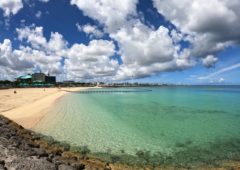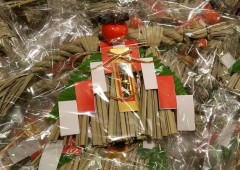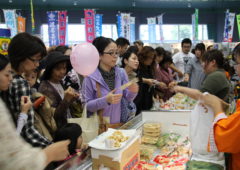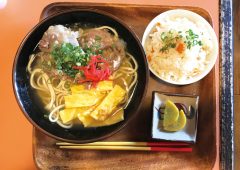2013.01.27
Humpback whales take limelight
By Bill Charles

A humpback whale breaches the surface as whale watchers on boats look on. Photo courtesy of Cerulean Blue Co. that arranges whale watching tours from Hamagawa Fishing Port in Sunabe, and has a policy of guaranteeing the sight of whales.
They are big and slow, but they love to play and have fun.
Humpback whales are making their annual migration to Okinawa waters, and now it’s easy for people to watch the lumbering mammals in the Kerama Islands, near Naha. Tours are the simplest way to join Mother Nature as her ocean species show off for you.
Perhaps the best deal this year is offered by Cerulean Blue who have twice daily tours

Tourists on a Cerulean Blue whale watching tour snap photos as a humpback calf flips its tail fin next to their boat.
departing at 9:30 a.m. and 1:30 p.m. from Chatan Hamagawa Fishing Port near Kadena Air Base. Discounted tour prices are ¥4,000 for adults, ¥2,900 for children 5~11, and ¥1,000 for kids 4 and under. The best part of their offer is that in the event no whales are seen, a free ticket will be issued for a guaranteed unforgettable experience. Cerulean Blue reservations are at 080-3904-3767.
The Zamami Whale Watching Society is responsible for dozens of tours now through March, the peak whale watching season. The entire season is being billed the Zamami Village Whale Watching Festival. The twice daily tours depart Zamami Port at 10:30am and 1pm. Reservations and tickets are available through the Society at (098) 896-4141, Tickets are Y5,250 for adults and Y2,625 for children. Dive Shops and travel agencies in Zamami, Tokashiki and Naha all have tour programs throughout the coming weeks.
Getting to Zamami, one of the larger of 20 islands in the Kerama Island Group, is easy from Naha’s Tomari Port. The cruises take 1-2 hours, and leave Tomari 2-3 times each day. Call 868-4567 for reservations and information. Other ferries ply the route from Naha’s Tomari Port to Tokashiki Island. From there, local cruises venture into the whale watching areas. Another option is to fly from Naha Domestic Airport to Kerama Airport on Fukaji Island, then pick up a boat for the tour. Several RAC flights make the run daily, each taking about 15 minutes.
The choice of watching for whales from a moving boat, or from the Whale Conservatory in Unazati on Zamami Island, is yours. It’s from the Conservatory there that the whales are spotted by Society members, and the location relayed to the ships. For those with an equilibrium situation, it’s a recommendation. Another ashore site on Tokashiki Island is the Okinawa National Youth Center atop Mt. Akama. The Center offers not only the view, but inexpensive accommodations and more.
However, the key is getting to Zamami in order to take the whale watching boat. A morning high speed vessel “Queen Zamami” leaves from Naha at 9 a.m., arrives Zamami at 9:50 a.m., connects with the whale watching boat tour that starts from Zamami Port at 10:30 a.m., then returns to Zamami Port at 1 p.m. The return Ferry Zamami arrives Naha at 4:30 p.m., while the Queen Zamami trip arrives back in Naha at 5:10 p.m. The Afternoon whale watching starts from Naha aboard the Ferry Zamami at 10 a.m., connecting to the whale watching boat tour at 12:30 p.m. The tour ends at 3 p.m. and Queen Zamami returns to Naha at 5:10 p.m.
Jumbo Tours runs twice daily tours at 8:30 a.m. and 1:30 p.m., taking 4½ hours from Marine House Shiisaa Naha Branch. Fees of ¥4,800 for adults over 13 and ¥2,800 for kids 6~12 and ¥2,000 for infants 3~5, include boarding, guide in English and Japanese, drinks, raincoat and rental fee for life jacket.
Whale watching is fun, but a couple words of caution. If you are easily seasick, the best bet is to watch for whales from on shore. If you’re on a boat, wear warm, waterproof clothing and shoes because the winds often make it feel cold. Remember too that whales are creatures, and not objects. Zamami officials say whales are seen about 80% of the time, but there are no absolute guarantees.
Dive shops and travel agencies in Zamami and Tokashiki, as well as Naha City, offer tour programs throughout February and March. Many tours begin from Naha Port. Marine Corps Community Services is running Whale Watching Tours throughout February and March. Tours are slated for February 3rd, 9th, 10th, 17th, 23rd and 24th, from 8 a.m. ~ 3 p.m. The fee is $64 for adults and $43 for kids 4~11. No children under four are permitted, and pregnant women are not allowed. Tour participants are encouraged to bring Japanese yen for lunch and purchases. Information is available at Tours Plus.
Reefters runs tours through April 8th from Miegusuku Port in Naha City. Adults are ¥3,900 and kids under 12 ¥2,900. Make reservations at (098) 862-3496. Okinawa Tropico whale watching tours run through March 31st from Naha Coastal Fishing Port. Adults are ¥3,800 and kids under 12 ¥2,800. Make reservations at letter@okinawa-tropico.com. Top Marine Zampa runs tours from Toya Port in Yomitan Village through March 31st. Tickets are ¥4,800 for adults and ¥3,800 for kids 6~11. Children under 6 are ¥500.
On the Air Force side, Kadena Information, Tickets and Travel is running Whale Watching Tours every weekend in February. Travelers are encouraged to bring sunscreen, a raincoat, camera and snacks. Nobody younger than four years of age is permitted aboard the boats.
Watching the whales, which consume 1-1½ tons of fish and krill a day, offers good photo opportunities. Zamami Whale Watching Society also has literature, photographs and post cards, and souvenirs available.
The Kerama Islands are 25 miles west of Naha. The area was once a popular whaling ground, but became overhunted. Today, the Whale Watching Society has a campaign under way to repopulate the area and restore the region as a principle whale breeding ground. It appears to be working, as humpback whales make the annual trek to the Keramas to give birth to their young, then nurture them in the warm, quiet waters.
After the whale population was decimated, the humpbacks in the region fell under protection of the International Whaling Commission, which in 1966 banned their hunting. The Russians continued illegal catches until being pressured to stop in the 1970’s, allowing the 25-40 ton mammals to regenerate. There are now 35,000~45,000 humpbacks, about 1/3 of the previous population.
Humpback whales are part of a family of species including the blue whale, fin, minke, sei and Bryde’s whales. Black, with a mottled black and white underbelly, the humpbacks grow to lengths up to 52’ (16 meters). They feed on fish and krill, a shrimp-like crustacean, gumping down 1~1½ tons of food a day.
The whales are active and energetic, enjoying splashing and doing flips in the water. They are unique, with dorsal fins on their backs and ventral plaits running from the tip of the lower jaw back to the belly. Scientists explain that the color and shape of those fins and plaits, as well as the uniqueness of the tail fin, are as individual as fingerprints from whale to whale. No two are alike.
Humpback whales sexually mature in the six-10 year age range. Females calve once every 2-3 years, with gestation taking 12 months. The birthing ground is the Kerama Islands, which brings back the reasons for the whale watching tours.


 2024.04.10
2024.04.10 2024.01.31
2024.01.31 2024.01.02
2024.01.02 2023.12.27
2023.12.27 2023.11.16
2023.11.16 2023.11.14
2023.11.14 2023.11.10
2023.11.10 2023.10.26
2023.10.26 2023.10.16
2023.10.16 2023.09.14
2023.09.14






